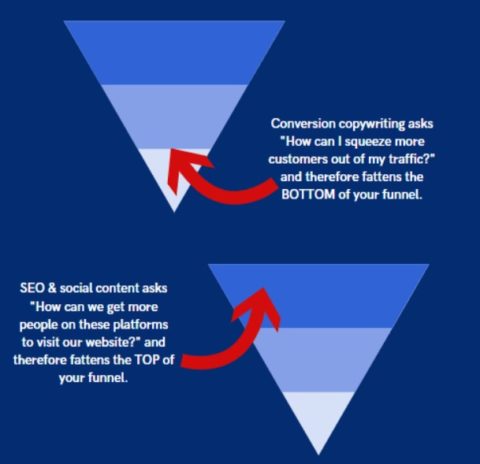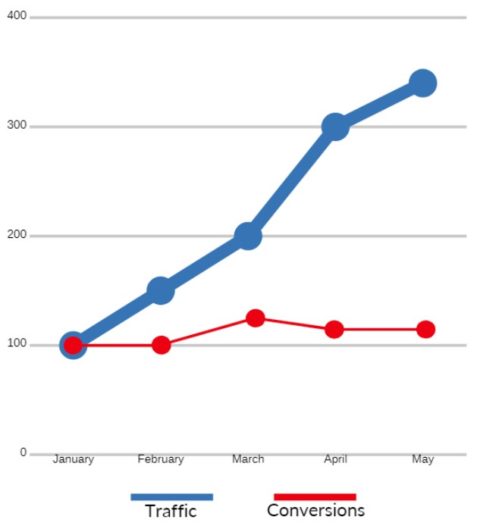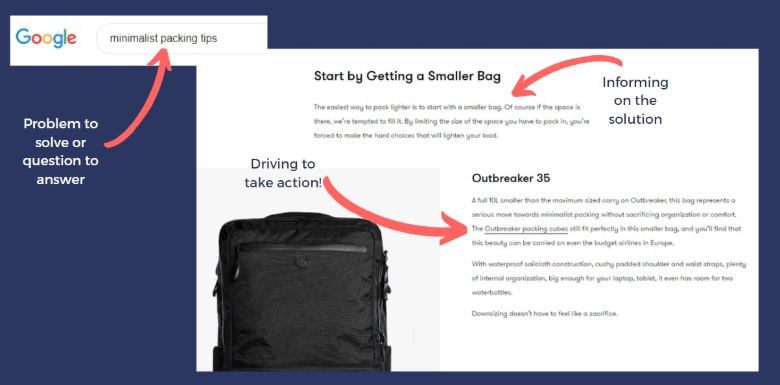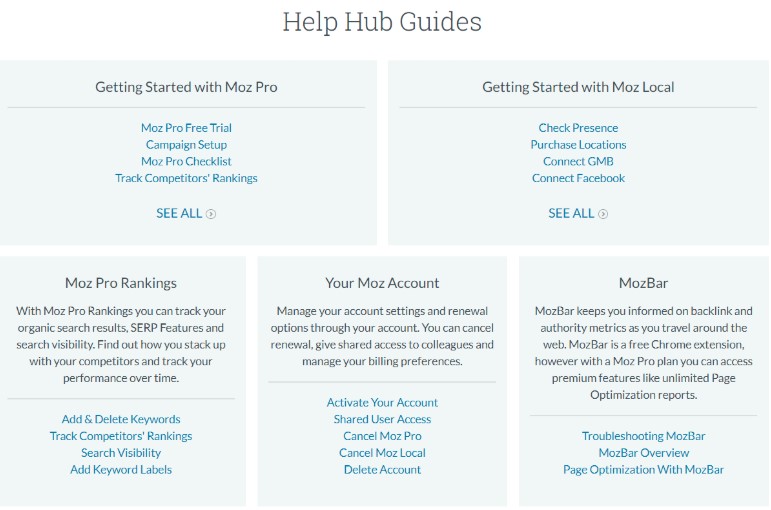18 Jul There Are No Universal Truths in Content Marketing (Sort Of) via @Kammie_Jenkins
“What’s the best…”
Let me stop you right there. The answer is “It depends.”
Ah yes, one of the most frustratingly glib retorts known to man.
But you know what?
I think it’s high time we started embracing it.
It’s in the “it depends” moments when we:
- Start to think strategically.
- Stop latching onto every shiny new tactic we see in our news feed.
- Finally stop blindly following every “best practices” checklist or correlation study and start critically examining everything through the lens of our unique needs.
We need to embrace the fact that there are no universal truths in content marketing.
Sort of.
What Are You Trying to Do?
When I say there are no universal truths in content marketing, I’m not saying that there aren’t objective best practices we need to follow (hence the “sort of”).
If we want something to show up in search results, we can’t accidentally leave a noindex tag on it.
If we want our content to rank for “What’s the best dog breed?” (it’s labs, by the way), we need to provide a satisfying answer to that question.
There’s no one-size-fits-all approach to content.
How you choose to approach content needs to differ depending on what you’re trying to accomplish.
The logic here is similar to the popular SEO concept of “searcher intent.”
We know that behind every query is a person with a unique need, and that the qualities Google looks for when ranking pages in their index will differ to meet these different intents.
It’s why we can’t say things like “pages need to be 2,000 words to rank in search engines” – that might be perfect for a blog post, but horribly overkill for a product page.
In the same way, behind every organization is a unique set of goals. Those unique goals will require unique strategies to get there, including content strategies.
5 Popular Marketing Goals & Corresponding Content Strategies
Saying content needs to differ by goal is one thing, but how do we actually put this methodology into practice?
Let’s look at five common marketing goals and what types of content are best suited to meet those needs.
1. Brand Awareness
Brand awareness asks the question, “How do we get the attention of people that don’t know about us yet?” That’s why top-of-funnel, informational content is great for brand awareness.
If someone doesn’t know about Soapboxly (my business), I’m not going to attract them with a post on “Soapboxly’s Approach to Content.”
That post might rank for queries like “Soapboxly content,” but a brand-unaware person would never search for that.
I could even pay to promote that content so it shows up in their feed, but due to an unfamiliarity with my brand, they probably wouldn’t click on it.
What would a brand-unaware person search for and click on? Something that speaks to their needs, desires, or quest for information!
Here are some practical tips for creating brand awareness content:
- Uncover Questions: Use a keyword research tool to see what questions people are asking about your product, service, or niche. Create content that provides the best answer to those questions. When those people search for information, the goal is that they’ll find your content!
- Observe Your Audience: Learn where your audience spends time and see what content they engage with. Use to find topic ideas and then promote your content on those channels.
- Make Your Brand Known: Top-of-funnel content isn’t sales-forward by nature. People are visiting your page for information, not to learn about your brand. However, if there are no mentions of your brand at all, it probably won’t help your bottom line. Host your informational content on a template that includes your logo and branding, and throw in a few no-pressure links to your other content to get your readers more familiar with you.
Another great way to achieve brand awareness is through digital PR.
“Big content” pieces (e.g., original research or finding new and creative ways to communicate data sets) are gold for content-hungry publishers.
Create something original and noteworthy that publications will want to feature, and you’re on your way to getting your brand exposure to a wider audience.

 A “big content” piece by Siege Media for their client CarRentals.com that got the brand featured in publications like Fox News and Jalopnik.
A “big content” piece by Siege Media for their client CarRentals.com that got the brand featured in publications like Fox News and Jalopnik.2. Social Media Reach & Engagement
Brands often have social media reach and engagement goals because they understand the benefits of connecting with their audience in the places they spend the most time.
What type of content can help a brand get closer to this goal?
In order for content to produce positive social engagement, you should:
- Write with the specific channel in mind: If you know your target customer is active on Twitter, take note of the characteristics of content that’s shared often on that channel. Your content should fit that model.
- Choose a topic that resonates with the audience: Pay attention to the topics and formats of the content your audience shares on specific channels. For example, you might notice “career development” is a popular theme on LinkedIn or that “Ultimate Guides” perform well on Facebook.
- Promote it: Extend the reach of your content beyond your existing audience by utilizing paid promotion options. For example, you can boost your post on Facebook. This reaches people who will likely be interested in your content but haven’t followed you yet.
Thought leadership can also be an important piece of this puzzle, helping brands stand out and get more engagement from an audience that’s likely being hit with the same messages over and over.
Thought leadership content should address a topic your audience is interested in, but from a new angle.
Because thought leadership introduces a new concept, or at least a new way of thinking about a popular topic, there’s not always existing demand to help it get traffic from places like organic search.
However, if it strikes a chord with your audience when distributed on your social channels, it can lead to a ton of social traffic.
3. Increase Conversions/Sales
Customer acquisition is going to be a major goal of most any marketing department, but how does content fit into that mix?
Often brands think of content in primarily top-of-funnel terms. The thought is that content can bring awareness and traffic, but it lives far away from revenue.
Not true.
Conversion-focused copywriting is all about words that sell.
Whereas most traffic-focused content exists to educate and entertain, copywriting’s main goal is to squeeze more sales out of your existing traffic.
Adding more visitors while your conversion rate remains steady will still get you more customers/leads, but there’s often much to be gained by turning more of your existing visitors into customers.


That’s why traffic-to-lead ratio is often a priority KPI on marketing teams.
Yes, we want to increase our traffic, but are our leads/customers increasing with it?


You can even use top-of-funnel content to drive people down your funnel. Capture the traffic by ranking for an informational query.
Then, once the visitor arrives, they learn not only the answer to their question, but also that your business offers a solution to that problem.
Take a look at the example below. A person is coming to the search engine with a question – they want to know how to pack lighter.
The page in the top organic spot on this SERP comprehensively informs on the answer, but it doesn’t stop there.
They use this top-of-funnel content to not only say “here’s your answer” but “here’s how our product is a solution to your problem.”
It’s a brilliant way to leverage informational content for transactional goals.

 Screenshot from my SearchLove Boston 2019 deck, depicting a post from Tortuga Backpacks
Screenshot from my SearchLove Boston 2019 deck, depicting a post from Tortuga BackpacksHow can you write content that increases conversions?
- Talk to your customers: Ask them why they chose you and stay with you. Highlight that in your copy.
- Talk to your sales team: Ask them about common questions, concerns, or objections to your product or service, then ask them what turns some of those from skeptics into customers. Highlight that in your copy.
- A/B test your messaging: Use a tool like Google Optimize to test different headings and calls-to-action to see which converts the highest.
- Leverage other channel data: See what messaging produces the most clicks, opens, etc. on other channels and incorporate that into your website copy.
4. Decrease Customer Acquisition Costs
Getting more customers is great. Making more money from customers than you spend on getting them is even better.
When lowering your customer acquisition costs (CAC) is a goal, creating content that ranks in search engines is one of my go-to recommendations.
Relying on paid advertising to send traffic to your content means that traffic is gone the second you stop paying for it.
If your content ranks organically in search engines, you’ll get sustained, free traffic.
Rank for more and more keywords. Earn more and more organic search traffic to your content.
In doing so, you’re increasing your pool of potential new customers without increasing the cost it takes to procure them.
5. Improve Customer Retention
We often think of content as solely an acquisition tool, but you can also use it to increase the lifetime value (LTV) of your customers.
For example, if you do content for a software company, you can make sure your product has extensive and easy-to-follow support documentation and in-app messaging.
You can even use content to showcase sample product workflows and unique use cases that can increase product utilization.
The goal here is to make your product so sticky that your customers can’t imagine their lives without it.

 Example of support documentation on Moz’s Help Hub (disclosure: I currently work with Moz)
Example of support documentation on Moz’s Help Hub (disclosure: I currently work with Moz)If you’re in the service industry (maybe you run a gym or do people’s taxes) you can use newsletter content to keep your business top-of-mind with your customers.
Use newsletter content to provide consistent value so your customers don’t leave to go elsewhere.
Most importantly: talk to your customers! You won’t know what content they’ll find helpful until you do.
Making ‘It Depends’ a Way of Life
Not always, but sometimes, we gravitate toward the quick tips, the how-to guides, and the cheat sheets.
Don’t get me wrong – there’s a time and a place for those. I just worry that, in the process, we’re losing a bit of our critical thinking.
The five competitor keyword analysis ideas I used to get more organic search traffic may not produce the same result for you.
And heck, maybe increasing traffic isn’t even an appropriate goal for your business right now!
The strategies and tactics you choose need to come from a deep understanding of your offering and goals.
- Do you sell an expensive software suite or a freemium tool?
- Are you offering a commodity or are you introducing something new to the market?
- Do you need more awareness or do you need to lose fewer customers?
Focus on answering questions like these first, and the appropriate content strategy will become a lot clearer.
More Resources:
- Why Content ‘Tactics’ Fail You & How to Become Relevant
- Content With Purpose: How to Set Goals for Every Content Piece You Create
- Content Marketing KPIs: Your Guide to Picking the Right KPIs for Content
Image Credits
In-Post Image #1: Siege Media
Screenshots taken by author, July 2019
Sorry, the comment form is closed at this time.